Quotations
Thought for Us
The important thing is not to stop questioning
A. Einstein
****************************************************************

The 10th Anniversary World Congress on Targeting Mitochondria will be held in Berlin on October 28-29, 2019. The themes of the Congress will focus on three major areas, the first being mitochondrial chronic diseases including aging, the second how to quantify mitochondrial dysfunction, and the third, how to target and manipulate mitochondrial function in order to develop mitochondria-based therapies.
Of general interest is mitochondrial dynamics in intracellular pathways, the emphasis here is to present an alternative to the recognized ATP synthase in chemiosmosis:
Chemiosmosis or Simple QED?
In the generation of ATP during respiration, chemiosmosis is the flow of hydrogen ions across the inner membrane of mitochondria providing power for producing work at the cellular level. However, the chemistry explanations of chemiosmosis are complex and are difficult to verify experimentally. A totally different approach to ATP synthesis based on the physics of simple QED is suggested.
ATP synthesis in mitochondria is proposed to occur by simple QED that does not depend on electron induced pumping of hydrogen ions across the inner membrane. Simple QED differs from the QED proposed by Feynman in that real and not virtual photons stand across the matrix between adjacent cristae surfaces of folds in the inner membrane, the EM energy at UV levels breaking oxygen double bonds to power ATP production. The source of UV is ATP energy released in the matrix. The human lung mitochondria showing the EM wave standing in the matrix between the fold formed between adjacent cristae is noted in the following figure.
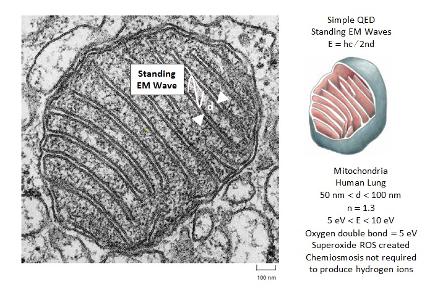
In the matrix with a spacing d between adjacent cristae (50 < d < 100 nm), the Planck energy E of the standing EM waves based on a refractive index n ~ 1.3 is beyond the UV, i.e., E ~ 5 to 10 eV thereby providing at least 500 kJ of UV radiation for every mol of ATP released. Depending on the molar concentration of oxygen in the matrix, the oxygen superoxide anion is formed by breaking the double bond of oxygen. The oxygen anions break down carbohydrate foods, and convert ADP back to ATP. Of importance, ATP release requires a continual supply of oxygen for the mitochondria to produce ATP.
In the mitochondria, simple QED is the source of hydrogen ions, i.e., the simple QED photon at 5 eV/mol of ATP provides the matrix with about 500 kJ/mol of ATP to create hydrogen ions by breaking O-H and H-H bonds at 459 and 432 kJ/mol of O-H and H-H reactants, respectively. What this means is simple QED clearly produces hydrogen ions in mitochondria from UV radiation thereby avoiding the unlikely successive and accumulative electron absorptions in chemiosmosis. Moreover, simple QED does not depend on the pH of the intermembrane space and anions are indeed created at UV levels. For over 50 years, chemiosmosis theory made the claim that the unlikely accumulated electron absorptions pumped hydrogen ions across the inner membrane, when in fact simple QED in the UV and beyond actually produced the hydrogen ions that power mitochondria. See preliminary Paper and Mitochondria conference Abstract
See the Mito Conference Presentation
ATP by Mitochondrial induced UV
Today, chemiosmosis is the accepted synthesis of ATP in mitochondria. Enzymes in the inner membrane of mitochondria transfer electrons from the oxidation of metabolism to molecular oxygen froming superoxide anions. The phosphorylation reaction is:
ADP + phosphate → ATP
Hydrolysis of ATP to ADP and phosphate is highly favorable in aqueous solution producing an energy release of 30.5 kJ / mol ATP. In contrast, the molecular mechanism of oxidative phosphorylation in metabolic breakdown reactions is converted into phosphate bond energy through a "high-energy intermediate", i.e., a chemical compound generated by an enzymatic oxidation-reduction reaction capable of transferring a phosphate group to ADP. But after decades of research, the "high-energy intermediate" was never found.
Chemiosmosis does not require a "high-energy intermediate". Instead, respiration and phosphorylation is coupled by an electrochemical gradient of H+ ions across the mitochondrial membrane, i.e., the flow of electrons through the respiratory enzymes is linked to a net movement of H+ across the inner mitochondrial membrane that creates a transmembrane electrochemical potential comprising an osmotic pressure and an electric field component. The electrochemical potential powers the ATPase, an enzyme which is also located in the inner mitochondrial membrane that carries out the phosphorylation of ADP to ATP.
ATP by chemiosmosis with oxidation by the electron transfer chain OR oxidation by the molecular mechanism by "high-energy intermediate" are both based on complex chemistry that is difficult to verify experimentally. In contrast, oxidation by mitochondrial induced UV radiation is simple and understood by all. But UV is only naturally available as exogenous solar radiation outside the body - not endogenous UV produced within the mitochondria of human cells.
In this regard, simple QED is proposed to produce endogenous UV within the mitochondria itself. Instead of chemiosmosis, ATP is proposed produced by standing EM waves of endogenous UV as shown below.
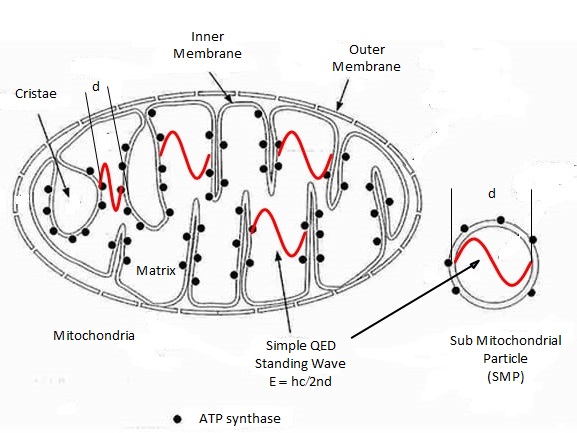
Simple QED differs from the QED proposed by Feynman in that real and not virtual photons stand across the matrix between adjacent cristae surfaces of folds in the inner membrane, the EM energy at UV levels breaking oxygen double bonds to power ATP production. Any submicron organelle produces endogenous UV provided metabolic heat is produced. In the figure below, standing EM waves are shown produced in human lung mitochondria including standing EM waves within submicrondrial particles (SMP).
A preliminary Paper on ATP produced by endogenous UV is available.
Dark Matter & Modified Gravity
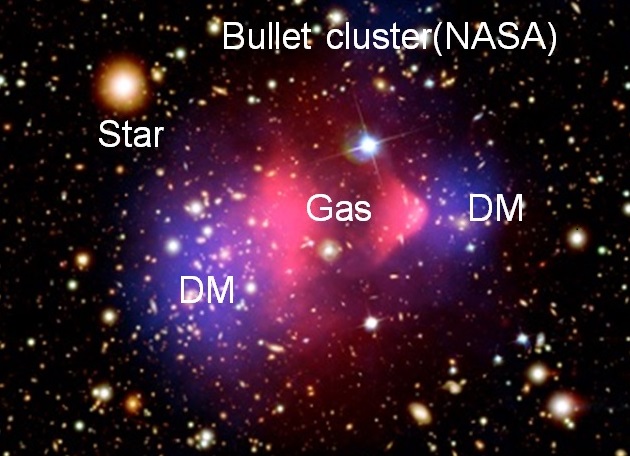
The relations between Dark Matter & Modified Gravity are being discussed at the Dark Matter & Modified Gravity Conference from 6 to 8 February 2019 at RWTH Aachen University, Germany. Interdisciplinary perspectives on Astrophysical and cosmological observations as well as explanatory gaps in the Standard Model of particle physics imply the existence of Dark Matter and/or a modification of our theory of space and time. The numerous Dark Matter and Modified Gravity approaches, even in the light of the vast amount of relevant collider based and astrophysical observations is complex, but the overlap of the research may allow for a simplification. One focus of this conference is Dark Matter searches at the Large Hadron Collider (LHC)and the connection between theories of gravity. Discussions are planned on choosing between the two research programs, and choosing between different models in each research program .
In this regard, a return of cosmology to Newtonian mechanics is proposed.
Since the 1930's, astrophysical observations have implied the existence of Dark Matter because high velocity were measured. In the 1970's, the M31 spiral galaxy was extensively studied and shown to produce a flat rotation curve that supported the notion that Dark Matter exists. Only a decade ago, GL also showed the Bullet Cluster could not stay together without d the existence of Dark Matter. GL stands for gravitational lensing. In the above figure, the red area represents X-rays and the blue shows the Dark Matter as derived by GL. However, direct experimental proof of a Dark Matter particle has not yet been found. In the alternative to the existence of Dark Matter, Modified Gravity has been proposed, but the agreement between numerical simulations of MOND and astrophysical observations is still only numerical, lacking any experimental verification.
It is important to note, the astrophysical observations were generally made with velocities inferred from Doppler`s effect and optical redshift and perhaps the procedure highly overstated the velocities. In this regard, cosmic dust that permeates the Universe is proposed to further redshift the light emitted from a distant galaxy thereby overstating the velocity of the galaxy to the extent that Dark Matter is thought to exist to keep the galaxy together. Unlike MOND, the redshift in cosmic dust is a physical mechanism well known from laser experiments of NPs in nanotechnology. NPs stand for nanoparticles.
Since Hubble, redshift of galaxy light in cosmic dust went unnoticed for almost a century because light interaction with NPs was assumed to follow classical physics and increase in temperature upon absorbing a galaxy photon. However, classical physics is not applicable as the dust is not macroscopic, but nanoscopic following the Planck law of QM requiring the heat capacity of the atoms in NPs to vanish, provided the NP is placed under high EM confinement. QM stands for quantum mechanics. Since EM confinement is naturally high in NPs because of their high surface-to-volume ratios, the galaxy photon is absorbed almost totally in the NP surface. Unable to increase in temperature, the NP cannot expand to relieve the surface heat, thereby providing the EM confinement for the atoms to make the heat capacity vanish. Lacking temperatures, photon absorption by a NP can only be conserved by a non-thermal mechanism proposed here as simple QED.
Simple QED relies on the high surface-to-volume ratios of cosmic dust NPs to create, non-thermal standing EM radiation inside the NP across the diameter d having half-wavelength λo/2 = d. In effect, a redshifted galaxy photon having wavelength ?o is created inside the dust particle depending on its dimensions, i.e., the energy of the galaxy photon adjusts within the EM confinement defined by the dimension between opposing dust surfaces. The speed of light c corrected for the refractive index n of the dust gives the Planck energy E of the redshifted galaxy light, E = h(c/n)/λo. On Earth, the galaxy light is observed to have wavelength ?o with redshift z = (λo - λ)/λ, where λo = 2nd. Once the Planck energy of the galaxy photon is absorbed in the dust surface is expended in forming the redshifted photon, the EM confinement vanishes allowing the redshifted photon to freely travel to the Earth.
CMBR is created in Our Solar System!!!
Dicke and others came to the conclusion that the Big Bang left behind residual radiation which would still be present in the Universe as black body EM radiation with a temperature of about 10 K. However Cosmic Background Radiation (CMBR) evolved from models of the Big Bang by Gamow beginning in 1948. Only later in 1965 did Penzias and Wilson measure the microwave EM radiation coming from space. Dicke did not believe that the radiation came from a cold source, and instead cold temperatures were produced during the Big Bang in the expansion of the Universe.
However, Universe expansion is not required to reach 2.725 K temperatures.
The 2.725 K CMBR temperatures is a natural consequence of our Solar System. Beyond the Planetary System, the Oort Cloud at 10,000 AU is naturally cold. In 1950, the Oort Cloud was inferred by studying the orbits of different comets as comets were permanent members of the Solar System and not random bodies. Unlike the disk-like Planetary System in the ecliptic of the Sun, the Oort cloud is spherical.
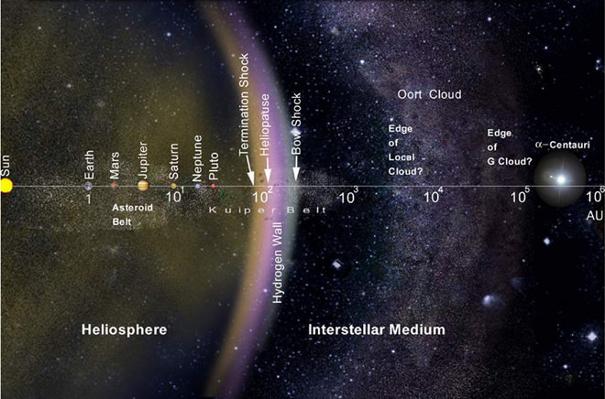
The equilibrium temperature T of the Oort Cloud may be estimated by assuming blackbody thermal radiation emitted by the Sun at temperature Ts is absorbed without reflection by the Oort Cloud.
T =Ts √(Rs/2D)
where, Ts = 5800 K and Rs = 693 x 106 m. From the above Figure, the distance D is arbitrarily taken as the midpoint of the Oort Cloud, i.e., D = 10,000 AU. For 1 AU = 150 x 109 m, T = 2.79 K. Similarly, the Earth at 1 AU from the Sun gives T = 279 K. The temperature of the CMBR at 2.725 K is close to the 2.79 K estimated from blackbody radiation at D = 10,000 AU.
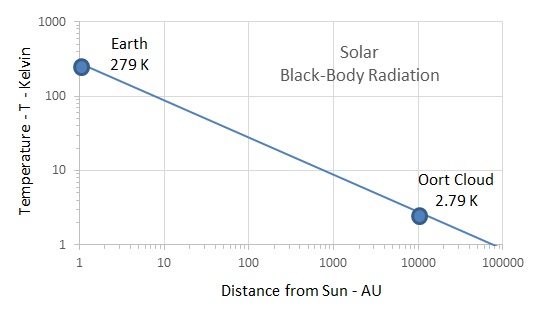
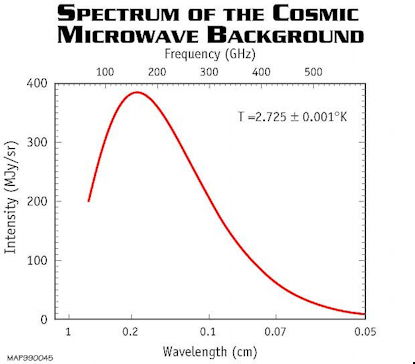
In conclusion,
Redshift of galaxies beyond the Oort Cloud are highly overstated on Earth by the dust in our and other Solar Systems. Although simple QED suggests dust absorption significantly redshifts emission lines from distant galaxies, any precise correction of galaxy velocities is not possible. Regardless, it can unequivocally be stated an expanding Universe based on dust redshift does not exist with Galaxy dynamics given by Newtonian mechanics.
Simple QED applied to the absorption of Lyα photons in dust NPs < 1 micron provides the basis for assessing CMBR anisotropy. Cosmic dust having radii < 0.04 microns produce anomalous microwave emission (AME) while redshift occurs for NPs > 0.04 microns.
Current AME mechanisms that excite NP rotation by IR emission from thermal fluctuations cannot be valid by the Planck law of quantum mechanics. Similarly, the UIR bands thought formed by increased temperatures of PAH molecules are also not valid.
Simple QED induced AME based on charge created upon absorption of Lyα photons exceeds the ionization potentials of most materials, i.e., AME occurs by spinning of simple QED induced charge. Cosmic dust need not be magnetic to produce AME.
The AME is caused by dust and is not as a relic of gravitational waves in an expanding Universe following the Big Bang. The CMBR spectrum is produced by thermal blackbody radiation from our Sun reaching an equilibrium temperature of 2.725 K in macroscopic particles at a distance comparable to the distance of the Oort Cloud from the Sun.
The CMBR as a consequence of our Solar System is described in a preliminary Paper